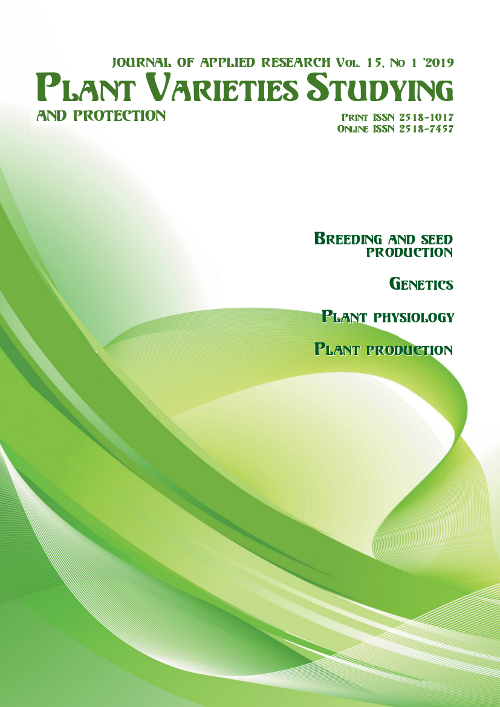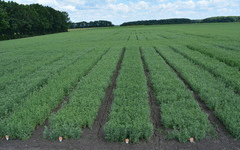Technological qualities of sugar beet root crops depending on fertilization and crop rotation
DOI:
https://doi.org/10.21498/2518-1017.15.1.2019.162492Keywords:
sugar beet, fertilizer rate, factory sugar output, loss of sugar in molasses, sugar content in roots, MB-factor, sugar yieldAbstract
Purpose. To study the peculiarities of technological quality formation in sugar beet roots depending on the system of fertilization and crop rotation.
Methods. Field, laboratory and statistical.
Results. The studies were carried out on typical chernozems in the vetch-oats – winter wheat – sugar beet rotation. It was revealed that in the crop-replaceable and grain-tilled crop rotation on the background of the use of N100P100K100 + 50 t/ha of manure sugar losses in molasses was 1.11 and 1.08%, in the crop-replaceable rotation with 5 t/ha of straw plowing under + N100P100K100 it was 0.99%. With an increase in the dose of potash fertilizer to 150 kg/ha (N100P100K150) and the use of 50 t/ha of manure + K150 MB-factor was 13.93%, while in the case of plowing straw under together with mineral fertilizers it was 13.76%. In the grain rotation, the purity of normally purified juice was high against the background of the use of N100P100K100 + 50 t/ha of manure – 96.03%, whereas in the crop-replaceable and grain-tilled crop rotation – 95.35 and 95.56%, respectively; for an increase in the rate of fertilizers up to N160P200K200 + 50 t/ha of manure – 95.07%, and an increase in the dose of potassium in the fertilizer system – N100P100K150 + 50 t/ha of manure – 95.84%.
Conclusions. An increase in the rate of fertilizers in the vetch-oats – winter wheat – sugar beet rotation leads to an increase in sugar losses in the molasses. In the grain-tilled crop rotation for the introduction of N160P200K200 + 50 t/ha of manure, the factory sugar yield decreased to 13.74%, with an increase in the potassium dose in the fertilizer system to N100P100K150 + 50 t/ha of manure, this indicator grows by 0.36%. In the case of plowing straw under on the background of N100P100K100, in the crop-replaceable rotation, the factory sugar yield is 8.15 t/ha, which is not inferior to the organo-mineral background of the sugar beet fertilization.
Downloads
References
Islamgulov, D. R., & Bakirova, A. U. (2017). Productivity and technological quality of sugar beet roots at diff erent harvest time. Saharnaâ svekla [Sugar beet], 6, 14–17. [in Russian]
Dutton, J., & Huijbregts, T. (2006). Root quality and processing. In A. P. Draycott (Ed.), Sugar beet (pp. 409–442). Oxford, UK: Blackwell Publ. doi: 10.1002/9780470751114.ch16
Jabro, J. D., Stevens, W. B., Iversen, W. M., & Evans, R. G. (2010). Tillage Depth Effects on Soil Physical Properties, Sugarbeet Yield, and Sugarbeet Quality. Commun. Soil. Sci. Plant Anal., 41(7), 908–916. doi: 10.1080/00103621003594677
Theobald, K. (2016). Welches Fruchtfolgeintervall ist optimal? Zuckerrübe, 2, 14–15.
Minakova, O. A., Putilina, L. N., Tambovtseva, L. V., Aleksandrova, L. V., & Lazutina, N. A. (2016). Influence of use of fertilizers in the main entering and into top dressing on productivity and technological qualities of sugar beet. Saharnaâ svekla [Sugar beet], 7, 12–16. [in Russian]
Roik, M. V., & Kornieieva, M. O. (2017). Ecological stability and plasticity of promising sugar beet hybrids. Saharnaâ svekla [Sugar beet], 3, 4–8. [in Russian]
Karpuk, L. M., & Prysiazhniuk, O. I. (2014). Mathematical models of sugar beet growth and development depending on climatic factors. Tsukrovi buriaky [Sugar beet], 6, 13–15. [in Ukrainian]
Ivanina, V. V. (2016). Biolohizatsiia udobrennia kultur u sivozminakh [Biologization of fertilization of crops in crop rotation]. Kyiv: Komprynt. [in Ukrainian]
Tsialtas, J. T., & Maslaris, N. (2005). Effect of N fertilization on sugar yield and non-sugars impurities of sugar beet (Beta vulgaris) grown under Mediterranean conditions. J. Agron. Crop Sci., 191(5), 330–339. doi: 10.1111/j.1439-037X.2005.00161.x
Kostin, V. I., Isaev, Yu. M., & Oshkin, V. A. (2017). Dependence of sugar and juice purity content on the amount of molassigenic substances. Saharnaâ svekla [Sugar beet], 7, 26–28. [in Russian]
Tsvei, Ya. P., Remeniuk, Yu. O., Honcharuk, H. S., & Nazarenko, H. I. (2010). Technological qualities of sugar beet roots depending on the characteristics of agricultural machinery. Nauk. pracì Ìnst. bìoenerg. kulʹt. cukrov. burâkìv [Scientific papers of the Institute of Bioenergy Crops and Sugar Beet], 11, 276–280. [in Ukrainian]
Tsvei, Ya. P., Shymanska, N. K., & Mazur, H. M. (2010). Dependence of technological quality of sugar beet from crop rotation and fertilization backgrounds. Nauk. pracìÌnst. cukrov. burâkìv [Scientific papers of the Institute of Sugar Beet], 11, 290–297. [in Ukrainian]
Yashchenko, L. A. (2003). Ahrokhimichne obgruntuvannia pidvyshchennia produktyvnosti tsukrovykh buriakiv na luchno-chornozemnomu karbonatnomu grunti Lisostepu Ukrainy [Agrochemical substantiation of increase of sugar beet productivity on meadow-chernozem carbonate soil of the forest-steppe of Ukraine] (Extended Abstract of Cand. Agric. Sci. Diss.). National Agrarian University, Kyiv, Ukraine. [in Ukrainian]
Tsvei, Ya. P. (2014). Rodiuchist gruntiv i produktyvnist sivozmin [Soil fertility and crop rotation productivity]. Kyiv: Komprynt. [in Ukrainian]
Schlinker, G. (2016). Stickstoffdüngung zu Zuckerrüben. Zuckerrübe, 1, 45–48.
Schönberger, H. (2015). Wie Viel Stickstoff brauchen die Zuckerrüben? Zuckerrübe, 2, 38–41.
Downloads
Published
How to Cite
Issue
Section
License
Copyright (c) 2019 Ukrainian Institute for Plant Variety Examination

This work is licensed under a Creative Commons Attribution-ShareAlike 4.0 International License.
Starting in 2022, the copyright to the publication remains with the authors
Our journal abides by the CREATIVE COMMONS copyright rights and permissions for open access journals.
Authors, who are published in this journal, agree to the following conditions:
- The authors reserve the right to authorship of the work and pass the first publication right of this work to the journal under the terms of a Creative Commons Attribution License, which allows others to freely distribute the published research with the obligatory reference to the authors of the original work and the first publication of the work in this journal.
- The authors have the right to conclude separate supplement agreements that relate to non-exclusive work distribution in the form in which it has been published by the journal (for example, to upload the work to the online storage of the journal or publish it as part of a monograph), provided that the reference to the first publication of the work in this journal is included.

























 Ukrainian Institute for Plant Varieties Examination
Ukrainian Institute for Plant Varieties Examination  Селекційно-генетичний інститут
Селекційно-генетичний інститут Institute of Plant Physiology and Genetics of the National Academy of Sciences of Ukraine
Institute of Plant Physiology and Genetics of the National Academy of Sciences of Ukraine
 The National Academy of Agrarian Sciences of Ukraine
The National Academy of Agrarian Sciences of Ukraine